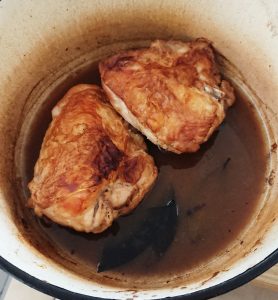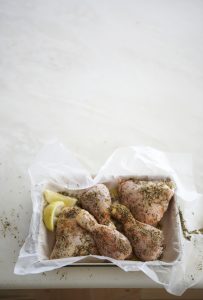
My mother did a lot of things remarkably well, but cooking chicken wasn’t one of them. She had one legendary roast chicken recipe (which I wrote about in Anna Trapido’s book Hunger for Freedom), plus a killer chicken Kiev, which really did deliver forth a gush of molten butter when stabbed with a fork.
That, along with a decent sweet and sour stirfry and a stand-up old school peri-peri chicken, was pretty much the sum of her winning poultry repertoire.
Since my mother’s variety of chicken dishes frequently failed to win favour with our dad, it was determined Pa would have T-bone steak whenever she experimented with a ‘sensational’ new recipe from her imported American McCalls’ women’s magazines. Pa used to tease Ma that she ought to write a recipe book titled ‘Adèlé de Waal’s 1 000 Ways to F%&k up a Chicken’, and after a few too many ruffled feathers, a lasting plan for peace was made.
And so it came about that the chief chicken cook in charge in our house would be the woman who looked after our housekeeping.
Alina, a doughty Basotho woman, was our domestic – or ousie, as we called domestics in those days. For the life of me I cannot recall her surname, which saddens and embarrasses me. I wish I knew what’d happened to her after my father died, because once my mother had passed away, Alina dutifully stayed behind to look after the old man. Pa became so dependent on her, he used to say (quite convincingly) that if Alina left, he’d go with her.
Alina knew exactly what to cook to please Dad’s palate, which wasn’t too difficult, since it mostly involved roast and grilled lamb with potatoes, gravy and rice. She had a nice line in Boerekosveg, too – cooked until mushy, and mashed up with lashings of salt, white pepper and margarine. Aah, and gravy, always gravy, made from meat juices boiled up and thickened with Bisto. Whenever I visited my widowed father from abroad, where I lived for 13 years, those were the familiar tastes and smells that greeted me when I entered the house via the kitchen – solid, no-nonsense, old-fashioned Freestate/Basotho cooking.
Seasonings for savoury Freestate dishes were limited to salt, white pepper, bay leaves, cloves, mixed spice or wonderpeper, nutmeg, onion, Worcester sauce and mace. Cinnamon and vanilla were stricly used for puddings and baking. My mother was quite exotic by local standards for incorporating fresh herbs (grown in her garden) into her cooking, but of course Alina saw no need for such frippery, and cooked plainly. Deliciously though and as I type, I find myself salivating at the memory of her simple food.
It was Alina’s pot-roast chicken pieces that I craved the most, all of those years that I travelled abroad. I’ve never tasted quite anything like it anywhere, and no matter how much I experimented, I could never quite match the exact flavours. I became convinced it must be her own unique recipe, since no equivalent existed in any Boerekos cookbook I examined over time. A bit like the filling for old-fashioned chicken pie, yet not as sweet and altogether spicier.
One Friday, after a completely frenetic week, I realised I hadn’t shopped for groceries and the cupboards were quite literally bare. Lunch was looming, the children would be home soon from school, and all I had was a pack of free-range chicken portions. No onions, leeks or carrots, no cream, no parsley or wine, not even a single scrap of garlic – a most unusual situation for me. (And certainly never repeated since.) I didn’t feel like pasta, and was rather in the mood for something very simple and down to earth. Fresh bay leaves were I all I had at my disposal. (I love using bay leaves in cooking, and always have fresh or dried somewhere. This is my religion.)
In a mild panic, I decided to fry the chicken portions in a heavy-bottomed cast iron casserole pot over very high heat after dusting all over with flour and seasoning generously with salt and white pepper. Putting the lid on whilst frying increases the moisture in the pot, which makes for much more tender chicken, and cooking portions with the bone in intensifies the flavour from within while the meat slowly caramelises and crisps up on the outside.
In a rather ‘oh what the hell’ mood of surrender, I tossed 4 or 5 cloves and 5 fresh bay leaves into the pot as soon as the browning had begun, replaced the lid and left the chicken to cook for about 20 minutes, with turns every 5 minutes. The oven was still on at 180 C from a baking recipe test session of the morning, so after 20 minutes, I sploshed a cup of chicken stock and a few shakes of a sherry vinegar bottle over the browned chicken pieces and, with the lid firmly in place, transferred the casserole with its contents to the oven to roast for another 40 minutes.
After half an hour in the oven, the captivating aromas emanating from the stove stopped me in my tracks – it smelled exactly, but precisely like the Freestate chicken I so fondly remembered. Literally, mouth-watering.
Alina always used to say ‘ek hoor hom, hy’s gaar’ – ‘I hear him, it’s done’ – when deciding if her cooking was done and ready to be served. In the same, curiously intuitive way, I could tell the exact point at which the chicken needed to come out of the oven. As I lifted the lid off the casserole, a heady rush of bay-scented steam bathed my face with the pure essence of nostalgia and happiness. Around the caramelised, meltingly tender chicken pieces, a golden puddle of savoury sauce had formed, reduced so perfectly as to need not a jot of seasoning or thickening. A real meal revolution, food therapy and the true meaning of heritage food all rolled into one.
It’s a great dish, and you should try it. It’s good with rice, brilliant with pap, but best of all with fresh white Government bread, sliced thickly and used to mop up the last remaining drops of jellifying jus.
Did I add you need to eat this from the pot? There, I’ve said it.
And now, because this is the internet and blogs need visuals, here is a picture of some fancy chicken.
